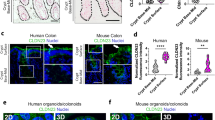Abstract
Claudin-4 is an unusual member of the claudin family; in addition to its role in epithelial tight junction barrier function, it is a receptor for the Clostridium perfringens enterotoxin. We have also found that claudin-4 is regulated in mucosal epithelium M cells, both in increased expression of the protein and in redistribution into endocytosis vesicles. Our ongoing studies are studying the potential for develo** ligands specific to claudin-4 for targeted delivery of cargo such as proteins and poly(dl-lactide-co-glycolide) nanoparticles to mucosal M cells. Methods for the study of claudin-4 movement within epithelial cells, and delivery of nanoparticles through targeted binding of claudin-4 are described.
Access this chapter
Tax calculation will be finalised at checkout
Purchases are for personal use only
Similar content being viewed by others
References
Sonoda, N., Furuse, M., Sasaki, H., Yonemura, S., Katahira, J., Horiguchi, Y., Tsukita, S. (1999) Clostridium perfringens enterotoxin fragment removes specific claudins from tight junction strands: evidence for direct involvement of claudins in tight junction barrier. J. Cell Biol. 147, 195–204.
Katahira, J., Sugiyama, H., Inoue, N., Horiguchi, Y., Matsuda, M., Sugimoto, N. (1997) Clostridium perfringens enterotoxin utilizes two structurally related membrane proteins as functional receptors in vivo. J. Biol. Chem. 272, 26652–8.
Colegio, O.R., Van Itallie, C., Rahner, C., Anderson, J.M. (2003) Claudin extracellular domains determine paracellular charge selectivity and resistance but not tight junction fibril architecture. Am. J. Physiol. Cell Physiol. 284, C1346–54.
Lo, D., Tynan, W., Dickerson, J., Scharf, M., Cooper, J., Byrne, D., Brayden, D., Higgins, L., Evans, C., O’Mahony, D.J. (2004) Cell culture modeling of specialized tissue: Identification of genes expressed specifically by Follicle Associated Epithelium of Peyer’s Patch by expression profiling of Caco-2/Raji co-cultures. Int. Immunol. 16, 91–99.
Clark, R.T., Hope, A., Lopez-Fraga, M., Schiller, N., Lo, D.D. (2009) Bacterial particle endocytosis by epithelial cells is selective and enhanced by tumor necrosis factor-receptor ligands. Clin. Vacc. Immunol. 16, 397–407.
Wang, J., Lopez-Fraga, M., Rynko, A., Lo, D.D. (2009) TNFR and LTβR agonists induce Follicle-Associated Epithelium and M cell specific genes in rat and human intestinal epithelial cells. Cytokine 47, 69–76.
Neutra, M.R., Pringault, E., Kraehenbuhl, J-P. (1996) Antigen sampling across epithelial barriers and induction of mucosal immune responses. Annu. Rev. Immunol. 14, 275–300.
Peterson, M.D., Mooseker, M.S. (1993) An in vitro model for the analysis of intestinal brush border assembly. I. Ultrastructural analysis of cell contact-induced brush border assembly in Caco-2BBe cells. J. Cell Sci. 105, 445–460.
Ling, J., Liao, H., Clark, R., Wong, M. S., Lo, D. D. (2008) Structural constraints for the binding of short peptides to claudin-4 revealed by surface plasmon resonance. J. Biol. Chem. 283, 30585–30595.
Rajapaksa, T. E., Stover-Hamer, M., Fernandez, X., Eckelhoefer, H. A., Lo, D. D. (2009) Claudin 4-targeted protein incorporated into PLGA nanoparticles can mediate M cell targeted delivery. J. Control Release.
Zhao, A., Rodgers, V.G. (2006) Using TEM to couple transient protein distribution and release for PLGA microparticles for potential use as vaccine delivery vehicles. J. Control. Release. 113, 15–22.
Coombes, A. G., Yeh, M. K., Lavelle, E. C., Davis, S. S. (1998) The control of protein release from poly(dl-lactide co-glycolide) microparticles by variation of the external aqueous phase surfactant in the water-in oil-in water method. J. Control. Release. 52, 311–320.
Acknowledgments
This work was supported by a Grand Challenges in Global Health award from the Foundation for the National Institutes of Health (FNIH), and Grants R21 AI73689 and R01 AI63426 from the National Institutes of Health.
Author information
Authors and Affiliations
Corresponding author
Editor information
Editors and Affiliations
Rights and permissions
Copyright information
© 2011 Springer Science+Business Media, LLC
About this protocol
Cite this protocol
Eckelhoefer, H.A. et al. (2011). Claudin-4: Functional Studies Beyond the Tight Junction. In: Turksen, K. (eds) Claudins. Methods in Molecular Biology, vol 762. Humana Press, Totowa, NJ. https://doi.org/10.1007/978-1-61779-185-7_9
Download citation
DOI: https://doi.org/10.1007/978-1-61779-185-7_9
Published:
Publisher Name: Humana Press, Totowa, NJ
Print ISBN: 978-1-61779-184-0
Online ISBN: 978-1-61779-185-7
eBook Packages: Springer Protocols




